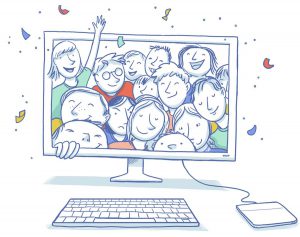Higher education institutions have adopted blended learning to actualize the benefits brought by technology. Specifically, the flexibility of learning afforded by blended courses make learning less dependent on specific space and time (Graham, 2006), and instructional method (Harding, 2012). In addition, blended learning is regarded as a more cost-effective approach than fully on-campus teaching (Harding, 2012). In addition to these potential benefits brought by blended learning, blended learning also provides a context in which students need to adapt themselves from the online environment to on-campus learning environments (Chiu, 2021) which at the same time, puts forward new requirements for teaching. Although many factors like teachers’ interaction with technology, academic workload, institutional environment, interactions with students, the instructor’s attitudes, and beliefs about teaching, and opportunities for professional development (Brown, 2016) are identified as factors influencing teachers’ adoption of blended learning, the institutional environment can always stand out in an authentic educational context. Many teachers are encouraged to use blended learning without thinking about whether it is aligned with their teaching goal and usually expect much from blended learning before they go to the classroom.
Potentials of blended learning
Blended learning is a balance of online learning and on-campus learning activities (Siemens, Gašević, & Dawson, 2015). Compared to on-campus and online learning, blended learning (through a Learning Management System) enables students to access learning materials whenever and wherever they want (Moskal, Dziuban, & Hartman, 2013) without the loss of obtaining in-person support and instruction in the classroom (Graham, Allen, & Ure, 2005). Additionally, blended learning can provide more effective instructional strategies to meet the course objectives than only online learning or fully on-campus learning (Graham et al., 2005; Morgan, 2002). This is probably because students can tailor their path of learning based on the personalized options afforded by blended learning (Medina, 2018). It can also improve students’ sense of belonging more than either on-campus or online learning (Rovai & Jordan, 2004). Zhu, Berri, and Zhang (2021) elaborated that, on the one hand, students may feel less disconnected because, with a blended learning situation, students can meet occasionally. On the other hand, they can have interactions and immediate feedback because they are interconnected on the online platform.
Challenges in Blended Learning
However, there are also many challenges in blended learning environments. Blended learning can be problematic if not appropriately designed and utilized. Even if appropriately designed and utilized it does not necessarily lead to the desired goal (Fisher, Perényi, & Birdthistle, 2021). Specifically, finding the optimal “blend” and coordinating all the elements is challenging for instructional designers and teachers of blended learning (Kaur, 2013). If the “blend” is not well-designed students will encounter difficulties in navigating between online learning and on-campus learning. Furthermore, there are technical challenges regarding ensuring student performance and achievement by utilizing and supporting appropriate technologies. In addition, isolation in online learning environments and distraction by non-academic online activities can hinder students’ engagement (Rasheed, Kamsin, & Abdullah, 2020). A crucial element is the amount of guidance and feedback in blended learning compared to on-campus learning due to the reduced in-person time with peers and teachers (Heinze & Procter, 2004). In all, blended learning requires more self-regulation skills and technology literacy than on-campus learning (Rasheed et al., 2020).
Technology as a Scapegoat
Ironically, although both advantages and disadvantages are afforded with the blended model, many stakeholders, like academics, course designers, and teachers, easily blamed technology for low engagement, increasing workload, and the failure of teaching. Specifically, some institutions and teachers were very glad when they heard they were allowed to return to campus. A teacher mentioned that she did not like teaching online with synchronous interaction because she felt that, to a large extent, she lost her control in building emotional bonds with students.
The distrust of technology and blended learning is very disappointing, especially to educational specialists who have invested huge amounts of energy in making blended learning more effective in learning. Joe O’Hara, a full professor of education at Dublin City University (DCU) and the president of the European Educational Research Association, commented “The ‘new normal? Two years of innovation and hard work consigned to the dustbin of (educational) history” under the news of “While some schools may close this week if local conditions are poor, they have been told days must be made up by cutting non-tuition activities.”
To be honest, we always have the problem of making education more effective. Teachers did not have scapegoats like technology to blame in the past rather than their own course design. It is always not the fault of any educational elements hindering the effectiveness of education. What really matters is how we use them in teaching and learning. To be specific, before deciding on using blended learning, think about how it can support the learning goals, fit specific learning tasks and facilitate the learning process.
Conclusions
There are no ways for us to go back to traditional teaching with the 2-year influence of online and blended learning during the pandemic. We highly recommend that teachers and course designers be more agentic in blended courses to make the best use of blended learning.
References
Brown, M. G. (2016). Blended instructional practice: A review of the empirical literature on instructors’ adoption and use of online tools in face-to-face teaching. The Internet and Higher Education, 31, 1-10. https://doi.org/10.1016/j.iheduc.2016.05.001
Chiu, T. K. (2021). Digital support for student engagement in blended learning based on self-determination theory. Computers in Human Behavior, 124, 106909. https://doi.org/10.1016/j.chb.2021.106909
Fisher, R., Perényi, Á., & Birdthistle, N. (2021). The positive relationship between flipped and blended learning and student engagement, performance and satisfaction. Active Learning in Higher Education, 22(2), 97–113. https://doi.org/10.1177/1469787418801702
Graham, C. R. (2006). Blended learning systems. In Curtis J. Bonk, Charles R. Graham (Eds.), The handbook of blended learning: Global perspectives, local designs, 1, pp. 3-21. Wiley Publishers.
Graham, C. R., Allen, S., & Ure, D. (2005). Benefits and challenges of blended learning environments. In M. Khosrow-Pour, Encyclopedia of Information Science and Technology, First Edition (pp. 253-259). IGI Global.
Kaur, M. (2013). Blended learning-its challenges and future. Procedia-social and behavioral sciences, 93, 612-617. https://doi.org/10.1016/j.sbspro.2013.09.248
Harding, M. (2012). Efficacy of supplemental instruction to enhance student success. Teaching and learning in Nursing, 7(1), 27-31. https://doi.org/10.1016/j.teln.2011.07.002
Heinze, A., & Procter, C. T. (2004). Reflections on the use of blended learning. http://usir.salford.ac.uk/id/eprint/1658/1/4247745025H__CP_-_paper9_5.pdf
Medina, L. C. (2018). Blended learning: Deficits and prospects in higher education. Australasian Journal of Educational Technology, 34(1). https://doi.org/10.14742/ajet.3100
Morgan, K. R. (2002). Blended Learning: A Strategic Action Plan for a New Campus. Seminole, FL: University of Central Florida.
Moskal, P., Dziuban, C., & Hartman, J. (2013). Blended learning: A dangerous idea? The Internet and Higher Education, 18, 15-23. https://doi.org/10.1016/j.iheduc.2012.12.001
Rasheed, R. A., Kamsin, A., & Abdullah, N. A. (2020). Challenges in the online component of blended learning: A systematic review. Computers & Education, 144, 103701. https://doi.org/10.1016/j.compedu.2019.103701
Rovai, A. P., & Jordan, H. M. (2004). Blended learning and sense of community: A comparative analysis with traditional and fully online graduate courses. International Review of Research in Open and Distributed Learning, 5(2), 1-13. https://doi.org/10.19173/irrodl.v5i2.192
Joksimović, S., Kovanović, V., Skrypnyk, O., Gašević, D., Dawson, S., & Siemens, G. (2015). The history and state of online learning (pp. 95-131). In G. Siemens, D. Gašević, & S. Dawson, S. (Eds.), Preparing for the digital university: A review of the history and current state of distance, blended, and online learning, pp. 55-92. Retrieved from http://linkresearchlab.org/PreparingDigitalUniversity.pdf
Zhu, M., Berri, S., & Zhang, K. (2021). Effective instructional strategies and technology use in blended learning: A case study. Education and Information Technologies, 26(5), 6143-6161. https://doi.org/10.1007/s10639-021-10544-w
The featured image is from “Does a Broken Screen Mean Your Laptop Is Doomed https://communitycomputerservices.com/does-a-broken-screen-mean-your-laptop-is-doomed/
The research team
Linyuan Wang, PhD candidate (ICLON, Leiden University)
Dr. Arjen de Vetten (ICLON, Leiden University)
Prof. Wilfried Admiraal (Oslo Metropolitan University)
Prof. Roeland van der Rijst (ICLON, Leiden University)




Recent Comments